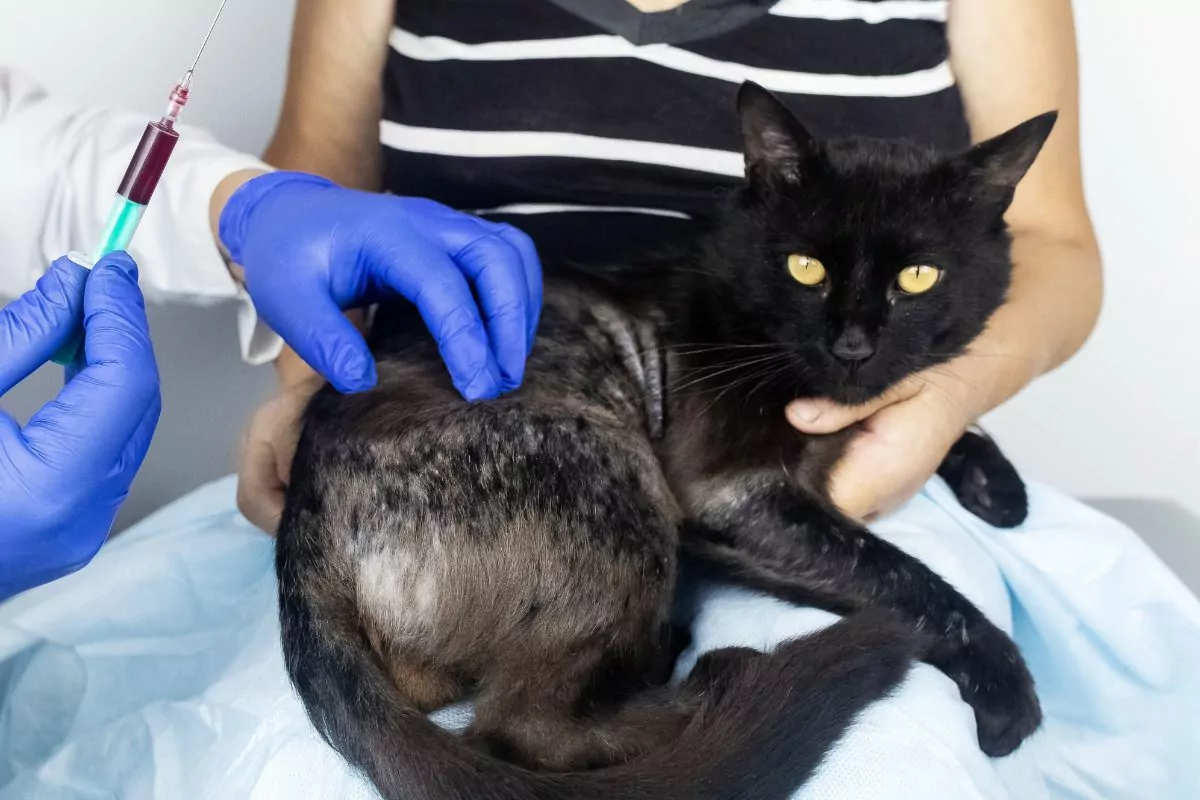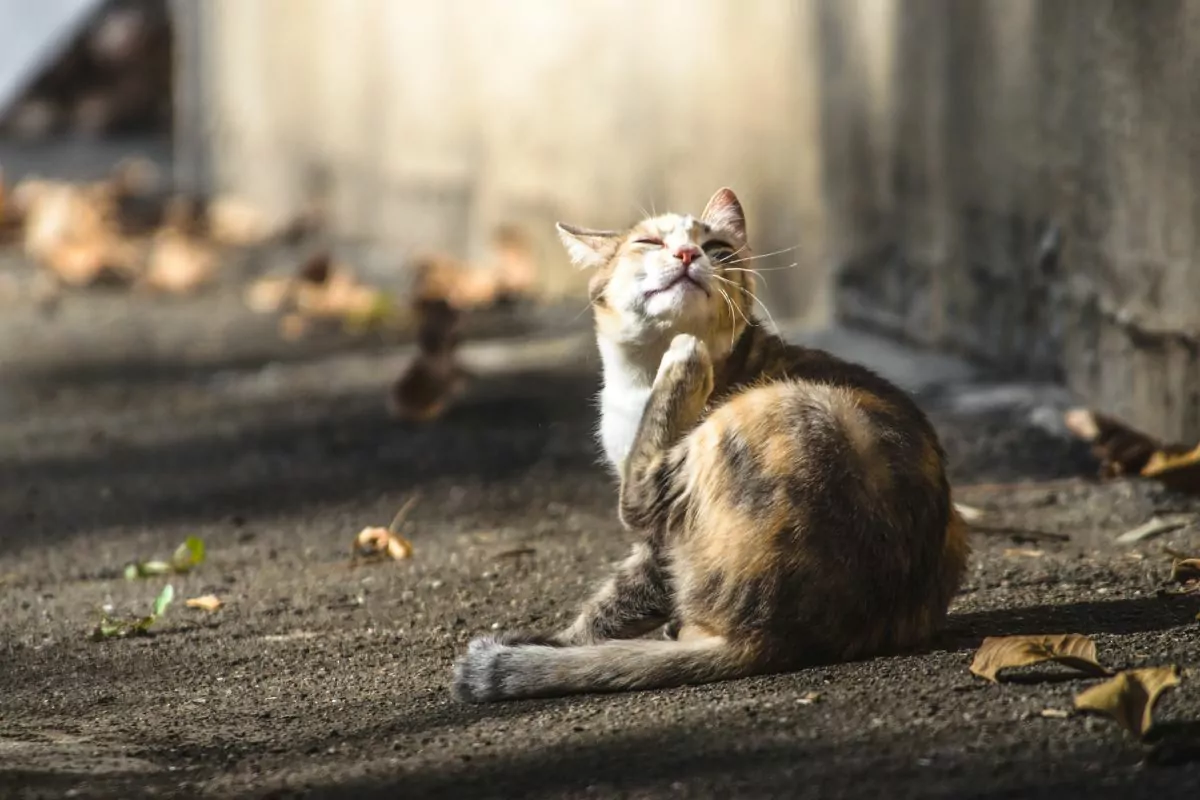What is Miliary Dermatitis in Cats?
Miliary dermatitis in cats is a skin condition characterized by numerous, small, localized, or generalized papules and crusted papules. Hence the word milliary derives from the Latin word milium, which means millet. These small papules under the cat’s fur are best felt rather than being seen.
This dermatological condition is usually an allergic reaction and can cause the appearance of a very itchy rash along with the formation of cat dry skin scabs.

What are the Causes?
Miliary dermatitis in cats is one of the most common feline problems in small animal dermatology. It is not a specific disease. It is secondary to many other diseases.
Regarding what causes miliary dermatitis in cats, several diseases are in close association with this dermatological condition.
Some of these diseases are:
- Atopy – atopic dermatitis
- Food allergies
- Dermatophytosis – a fungal infection of cats caused by Microsporum Canis
- Pemphigus foliaceus – an autoimmune skin disorder
- Flea allergy
- Otodectic mange
- Biotin and fatty acid deficiency
- Hypersensitivity to intestinal parasites
- Poor diet
Flea allergy (flea bite hypersensitivity) is the one that is most closely associated with this type of cat dermatitis. Warmer climates are another predisposing factor. Warm temperatures and humidity tend to make cats more susceptible to this condition.
How Do Vets Diagnose Feline Miliary Dermatitis?
It is quite challenging for veterinarians to diagnose the root cause of milliary dermatitis in cats. The veterinarian will perform a series of tests.
It is crucial to identify and treat the underlying condition; otherwise, dermatitis will not clear up, and flare-ups will occur.
Your veterinarian will start the health check with a thorough review of your cat’s medical history, along with a close inspection of its coat to check for the presence of any fleas. A detailed description by you of the cats’ symptoms will help to give a clearer picture.
The lesion on your cat’s skin is measured, thus determining size, texture, composition, and location.
Below is a list of additional tests that your veterinarian will need to perform to find the root cause and reach a definitive diagnosis:
- Biopsy
- Skin swabs
- Fur plucks
- Allergen-specific immunoglobulin E (IgE) testing
- Elimination food trial
- Fecal analysis
- Biochemical analysis and complete count of blood sample
- Cytology (to examine for bacteria) and skin scrapings (to investigate for mites)
- Insect control trial
Your veterinarian may also refer you to a specialist dermatologist.
The Signs and Symptoms
Cats with miliary dermatitis have a very itchy rash. They tend to lick and bite the affected area continuously. Due to the constant licking, the area develops a patchy appearance with a thin coat. The skin can become raw and possibly swollen.
Hair pulling, also known as barbering, will leave the cat with areas with no fur present.
The rash usually progresses to form dry skin scabs. These scabs are formed either from an allergic reaction or from self-trauma.
There is also a risk of infection. In the case of infection, the dry scabs’ appearance will change and look more like pustules or pimples.
You may feel these lesions while petting your cat, and often a description given is a “bumpy and crusty” feeling.
Areas that are most commonly affected are
- Lower spinal area
- Face
- Ears
- Flanks
- Abdominal area
- Base of tail

How to Treat Miliary Dermatitis in Cats
There is a wide range of treatments for miliary dermatitis in cats. The best treatment plan for your beloved feline depends on its needs. The veterinarian in charge will fully support you and help you choose the best option.
Treatment commonly involves using antihistamines, corticosteroids, antibiotics, and fatty acid supplements.
The main goal of all miliary dermatitis treatment for cats is to eliminate the root cause that is causing skin irritation. This root cause can either be an allergen in its environment, such as a food allergen, or an allergic reaction to the presence of fleas.
The therapeutic plan will also encompass treatment of any injuries caused by constant licking or scratching.
Here are some possible treatment plans that may be suggested to you by your veterinarian:
- Antibiotics fight off and clear infections by preventing the growth or killing of harmful bacteria.
- Corticosteroids: Oral and injectable steroids will help reduce swelling and inflammation, lowering the severity of dermatitis.
- Antihistamines: If the root cause is from a particular environmental allergen, antihistamines relieve these reactions.
- Topical ointments: Topical ointments will soothe irritated or inflamed areas on the cat’s skin.
- Medicated shampoo: A medicated shampoo will soothe inflamed areas on your cat’s skin and relieve the constant discomfort and itchiness caused.
- Dietary supplements: Fatty acid supplements and other dietary adjustments can help your cat avoid contracting feline dermatitis due to a food allergy and reduce the skin’s sensitivity.
The crusted papules should resolve with a symptomatic therapy of anti-inflammatory doses of steroids. Remember not to administer steroids until you rule out deep follicular mites, ringworm, and bacterial infections.
Is it Contagious?
So is feline miliary dermatitis contagious? This question is frequently asked by owners, especially when they have other pets or children.
The short answer is no; miliary dermatitis is not contagious to humans, pets, or cats.
However, since miliary dermatitis in cats is second to other underlying conditions, it also depends on the underlying condition as to whether it is contagious or not.
For example, if dermatitis results from a fungus, bacteria, or parasite, these, unfortunately, are contagious and infect humans and other animals within the household.
So caution is advised when handling affected cats, and good hygiene levels are imperative when dealing with fungal, parasitic, or bacterial infections. Always wash your hands after being in contact with a cat diagnosed with one of the above diseases.
Is There a Natural Remedy for Feline Miliary Dermatitis?
While no natural remedy will cure your cat of feline miliary dermatitis, some options can help soothe the irritating symptoms when used in conjunction with the treatment plan recommended by your veterinarian.
Military dermatitis cat coconut oil is such an example. You can rub this rich oil gently into your cat’s skin. It offers relief from the feeling of itchiness and nourishes the skin and coat. However, too much of a good thing can still have adverse effects. Only apply a few times and not in large amounts. The right amount goes a long way.
Bathing your cat in lukewarm water and gently massaging the skin with an oatmeal shampoo will also provide relief from itchiness and, at the same will, moisturize your cat’s skin. When using this method, no injuries are present, and the skin is intact.
If your cat tolerates it, bathing with Epsom salts is another great and economical way to soothe their skin. The salt reduces swelling, and the warm water moisturizes the scabs.
A warm towel wrap is a simple solution if your cat does not accept bathing. It helps relieve itchiness and softens the scabs. Simply soak a clean towel in warm water. Wring any excess water out of it and wrap the affected area.
Always consult your veterinarian before using miliary dermatitis cat home remedies for your fluffy friends. They will provide accurate advice and inform you if the remedy you have chosen will help your cat or if it is best to avoid it.
The Outcome for Felines With the Condition
Miliary dermatitis in cats has a very good, if not excellent, prognosis.
Diagnosing and treating miliary dermatitis in cats may be an elimination process in some cases or as simple as applying anti-flea treatment.
Whatever category your cat falls into, don’t fret. The condition is temporary, and with proper guidelines from your veterinarian, your cat’s skin will return to normal, and so will its luscious coat without the itchiness and dry scabs.
With proper and consistent therapy, cat dermatitis is taken care of with little trouble. Once you and your veterinarian identify and remove the source of irritation, the condition resolves fairly easily. However, if the root cause is an underlying allergy, you will need to monitor for flare-ups as allergies can only be managed and not completely cured.
Elderly cats also tend to develop more allergies with age. So be aware that your cat can develop reactions to new allergens.
The most crucial element to winning this battle is consistency and elimination. When you pinpoint what is causing your cat to feel uncomfortable, you must remove it from its environment and not re-introduce it. This reintroduction will, unfortunately, only provoke a flare-up.
Common Myths Busted About the Condition
Many owners believe because their pets spend most, if not all, of their time indoors, they are not at risk of having fleas. This statement couldn’t be further away from the truth. Fleas can be transferred from the outdoors into your house from your shoes or clothing.
Indoor cats with limited access to the outdoors or living in immaculate homes are more sensitive than outdoor cats. They have very sensitive skin, and the saliva from a flea bite can provoke an allergic reaction and begin the formation of irritating millet-shaped scabs.
Flea control is essential, and having a consistent plan has significant benefits.
The absence of a cat itching or scratching itself is also not a sign that your pet does not have fleas. Fleas transmit parasites such as Mycoplasma haemofelis, which can destroy the red blood cell causing anemia.
Bacteria, such as Bartonella, are also transmitted by fleas, and these bacteria cause cat scratch disease, which is contagious to humans.
Maintaining a regular anti-flea treatment plan makes a lot of sense for you and your health. It is low-cost, effective, and easy to implement. No matter if your cat has access to the outdoors or not.

That’s a Wrap
Vigilance is vital when dealing with feline miliary dermatitis.
If the root cause of the dermatitis is flea allergy-related, you must maintain a consistent anti-flea treatment plan year-round. The symptoms and dermatitis will reappear by allowing fleas to appear again in your cats’ environment. Please do not wait to see a live flea on your cat, as they are notorious groomers.
Some known environmental allergens that you can consider are:
- Materials in cat bags
- Carpets, rugs, or other furnishings within the household
- Pollen
- Household chemicals (detergents, etc.)
- Cat shampoo
Switching to a new food is imperative if the root cause is a food allergy. It would be best to eliminate the allergy-causing ingredient from your cats’ diet; otherwise, the allergen will trigger a new allergic reaction.
Removing environmental irritants is also a key component of your battle. Even though it can be tricky to detect what allergen causes the allergic reaction, the culprit irritants are most often successfully detected with a little patience and perseverance.
With a little trial and error, you can treat feline miliary dermatitis. The coat and skin of your cat will return to normal. In the case of any allergy-related flare-up, you may need to administer a round of corticosteroids.
Feline miliary dermatitis is not a condition that is not manageable and that poses a great threat to your cat’s life. If you adhere to your veterinarian’s treatment plan and eliminate any allergens, your cat will surely recover and feel comfortable in its skin again.
We hope this article has given you an insight into this common dermatological problem of cats. If your cat is battling feline miliary dermatitis, do not give up, and do not despair.
Follow your therapeutic plan; the only way is forward from here on. Your cat will feel comfortable again, and his or hers fur will grow back. You have won more than half of the battle by having patience and consistency.
